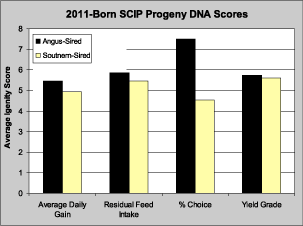Southern Carcass Improvement Project: Phase II Update (February 2012)
2011-Born Calves Placed on Feed in Early February
ASHLAND, KANSAS, February 24, 2012—Gardiner Angus Ranch announces continued progress with Phase II of the Southern Cattle Improvement Project (SCIP). Fifty-six head of 2011-born research calves were placed on feed earlier this month at Triangle H Feedyard near Garden City, KS. The overall group consists of 34 Southern × Southern and 22 Angus × Southern cattle. Three Angus sires and four Southern-breed sires are represented in this round of SCIP progeny. All calves are out of Southern-origin dams.
Average weight at feedyard arrival was 709 pounds, making these short-yearlings typical of many feeder calves being placed on feed at this time of year. Sam Hands, owner/manager of Triangle H Feedyard processed the SCIP cattle on February 7, administering his standard vaccination, implant, and anthelmintic protocol. The calves have been commingled since birth at Gardiner Angus Ranch and were managed identically both before and after weaning. In the feedyard, they were separated into their two sire groups and are being fed in side-by-side pens, receiving the same feed ration and health management. They are projected to stay on feed for approximately 175 days and marketed in late July. Complete feedyard performance and carcass data will be collected—the same as in Phase I of project.
Igenity® DNA results on key performance and carcass traits on Phase II cattle are shown in chart below. Angus-sired calves scored moderately higher for average daily gain and residual feed intake, suggesting they will outperform their Southern-sired counterparts while in the feedyard. The Angus-sired group also

holds a large advantage in %Choice, which should translate into a sizable difference in USDA Quality Grade at harvest. The average Igenity® score for %Choice was 7.5 for the Angus × Southern cattle versus 4.5 for the Southern × Southern calves. High-marbling Angus sires used in the SCIP research include GAR Predestined, GAR New Design 5050, and Ambush 28. These sires are known to improve quality grade, and they appear to have done so for their SCIP progeny by a wide margin. Lastly, but still of importance, DNA scores for Yield Grade were virtually even between the two sire groups.
"We are pleased with how Phase II of our research is progressing," says Mark Gardiner of Gardiner Angus Ranch. "The 2011-born calves were weaned in the fall, backgrounded for about 100 days, and then placed on feed as is typical for much of the industry's spring-born calf crop." Gardiner went on to mention that Igenity® DNA results were similar to differences observed in SCIP Phase I. "Planned matings have the advantage of more predictable outcomes," he explains. "The DNA results suggest we will again see material differences in how these cattle grow and grade, and that their final value and overall profitability will differ significantly as well, just as in Phase I."
In Phase I of the Southern Carcass Improvement Project, the Angus × Southern cattle produced an economic advantage of $92.72 per head over the Southern × Southern group. This advantage was created through faster growth, better marbling, larger ribeye size, and heavier carcass weights.
Gardiner Angus Ranch, in collaboration with Kansas State University and Virginia Tech, launched the SCIP during the spring of 2009 to determine how much carcass improvement could be made in one generation, using high carcass value Angus bulls on typical cows found in the Southern U.S. SCIP addresses the beef industry's long-standing need for higher quality grades and better overall carcass traits in Southern U.S. packing plants.